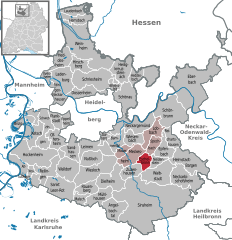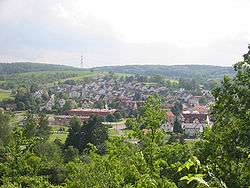Eschelbronn
| Eschelbronn | ||
|---|---|---|
|
View of the town | ||
| ||
 Eschelbronn | ||
Location of Eschelbronn within Rhein-Neckar-Kreis district 
 | ||
| Coordinates: 49°19′11″N 08°51′59″E / 49.31972°N 8.86639°ECoordinates: 49°19′11″N 08°51′59″E / 49.31972°N 8.86639°E | ||
| Country | Germany | |
| State | Baden-Württemberg | |
| Admin. region | Karlsruhe | |
| District | Rhein-Neckar-Kreis | |
| Government | ||
| • Mayor | Marco Siesing | |
| Area | ||
| • Total | 8.24 km2 (3.18 sq mi) | |
| Population (2015-12-31)[1] | ||
| • Total | 2,645 | |
| • Density | 320/km2 (830/sq mi) | |
| Time zone | CET/CEST (UTC+1/+2) | |
| Postal codes | 74927 | |
| Dialling codes | 06226 | |
| Vehicle registration | HD | |
| Website | www.eschelbronn.de | |
Eschelbronn is a village with 2,597 inhabitants in the Rhein-Neckar district of Baden-Württemberg, Germany. It is adjacent to Sinsheim.
History
Eschelbronn was already mentioned in the year 788/789 in a deed of donation from the monastery of Lorsch. In the end of the 13th. century it became property of the diocese of Speyer. In 1267 a castle of wood was built and later in 1375 was transformed to a moated castle of stone. In 1526 the population were converted to Lutheranis. In 1803 Eschelbronn became a part of Baden. 1807 the village joined the district of Waibstadt and was assigned 1813 to the district of Sinsheim, which in the year 1973 became the Rhine Neckar Area.
Economy
In former times the main income source from the inhabitants was agriculture, however later in the 18th century the weaving mill of lines became more and more important. Since the end of the 19th century Eschelbronn is well known for its furniture manufacturing industry.
References
External links
| Wikimedia Commons has media related to Eschelbronn. |

